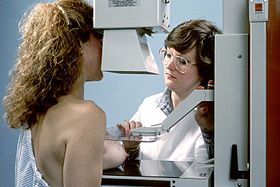| Breast cancer screening | |
|---|---|
 A woman having a mammogram |
Breast cancer screening is the medical screening of asymptomatic, apparently healthy women for breast cancer in an attempt to achieve an earlier diagnosis. The assumption is that early detection will improve outcomes. A number of screening tests have been employed, including clinical and self breast exams, mammography, genetic screening, ultrasound, and magnetic resonance imaging.
A clinical or self breast exam involves feeling the breast for lumps or other abnormalities. Medical evidence, however, does not support its use in women with a typical risk for breast cancer.[1]
Universal screening with mammography is controversial as it may not reduce all-cause mortality and may cause harms through unnecessary treatments and medical procedures. Many national organizations recommend it for most older women. The United States Preventive Services Task Force recommends screening mammography in women at normal risk for breast cancer, every two years between the ages of 50 and 74.[2] Other positions vary from no screening to starting at age 40 and screening yearly.[3][4] Several tools are available to help target breast cancer screening to older women with longer life expectancies.[5] Similar imaging studies can be performed with magnetic resonance imaging but evidence is lacking.[2][6]
Earlier, more aggressive, and more frequent screening is recommended for women at particularly high risk of developing breast cancer, such as those with a confirmed BRCA mutation, those who have previously had breast cancer, and those with a strong family history of breast and ovarian cancer.
Abnormal findings on screening are further investigated by surgically removing a piece of the suspicious lumps (biopsy) to examine them under the microscope. Ultrasound may be used to guide the biopsy needle during the procedure. Magnetic resonance imaging is used to guide treatment, but is not an established screening method for healthy women.
- ^ Cite error: The named reference
Cochrane03was invoked but never defined (see the help page). - ^ a b Siu AL (February 2016). "Screening for Breast Cancer: U.S. Preventive Services Task Force Recommendation Statement". Annals of Internal Medicine. 164 (4): 279–96. doi:10.7326/M15-2886. PMID 26757170.
- ^ Cite error: The named reference
CD001877was invoked but never defined (see the help page). - ^ "Guidelines". www.acraccreditation.org. Archived from the original on 26 July 2024. Retrieved 22 February 2021.
- ^ Schonberg M. Breast cancer screening: at what age to stop? Archived 2011-10-04 at the Wayback Machine Consultant. 2010;50(May):196-205.
- ^ "Improving cancer screening in the European Union". 2 March 2022. Archived from the original on 2022-03-01. Retrieved 10 March 2022.